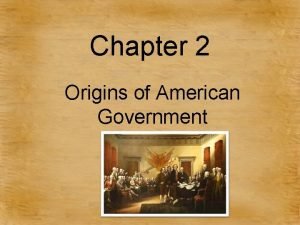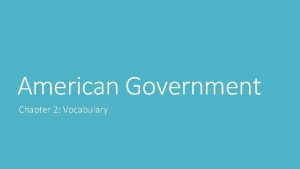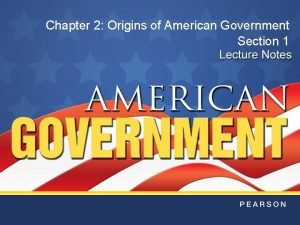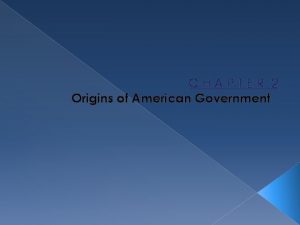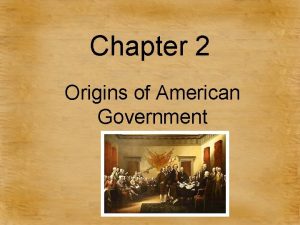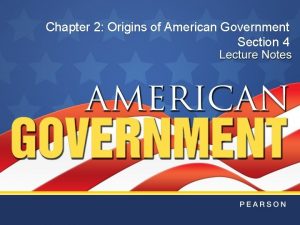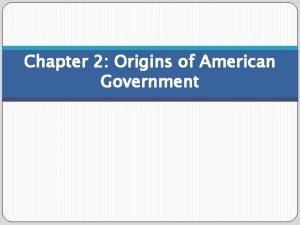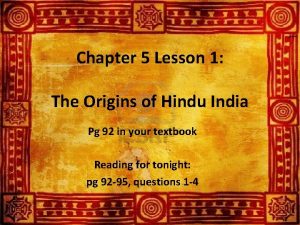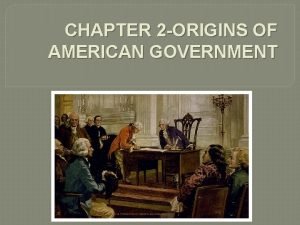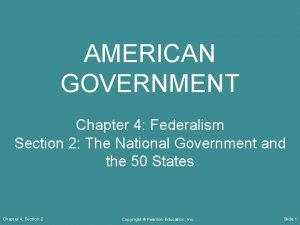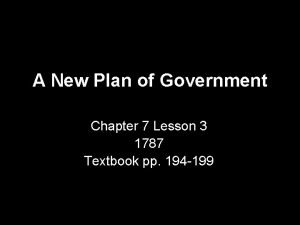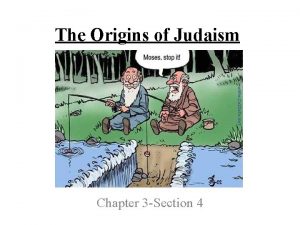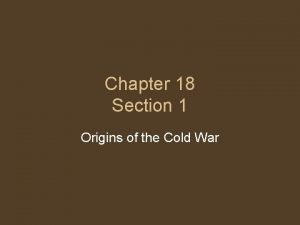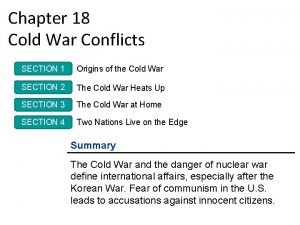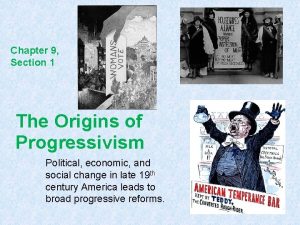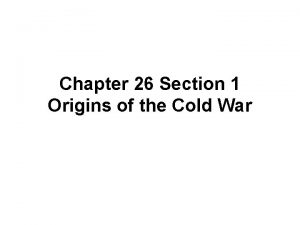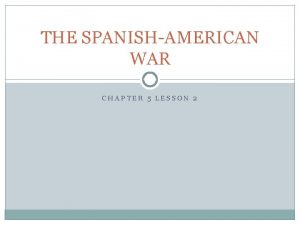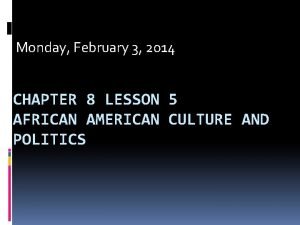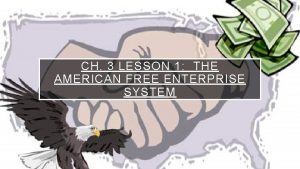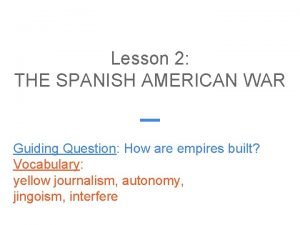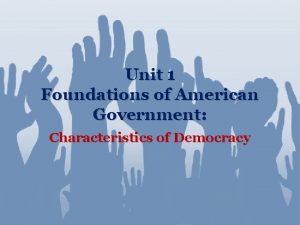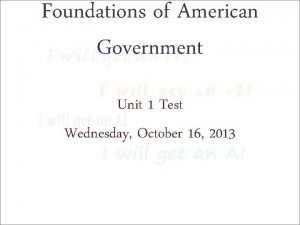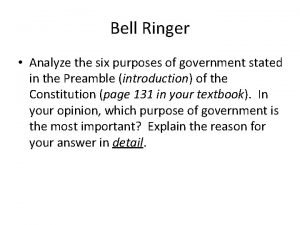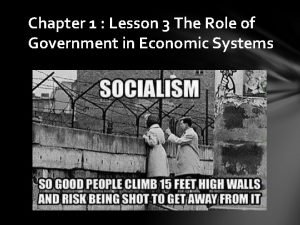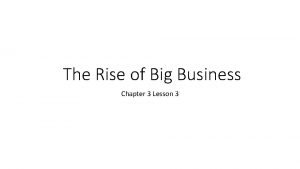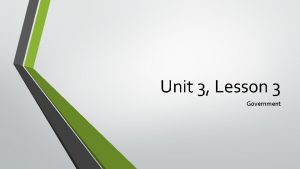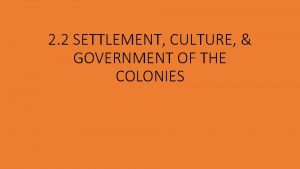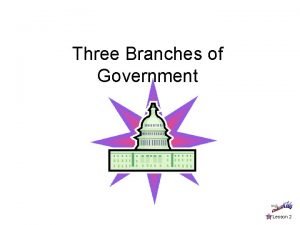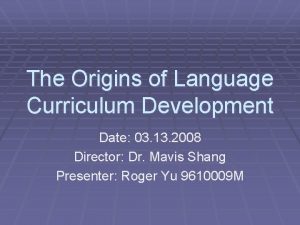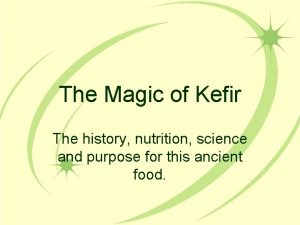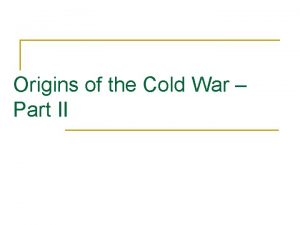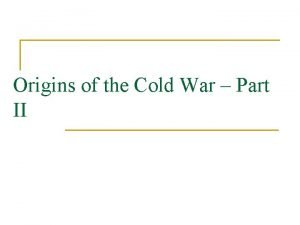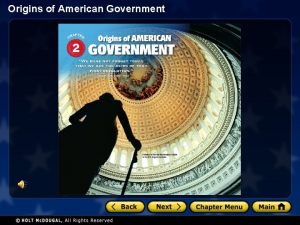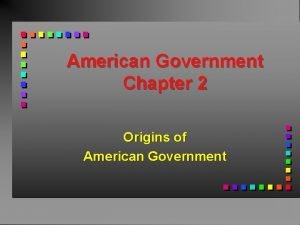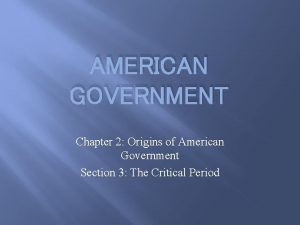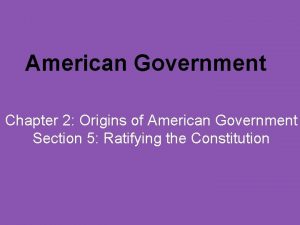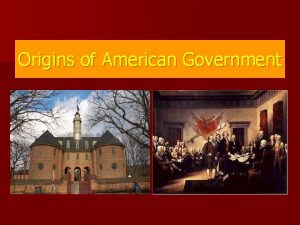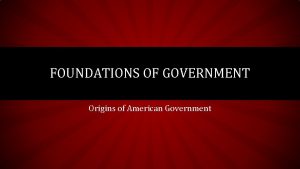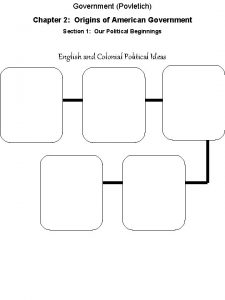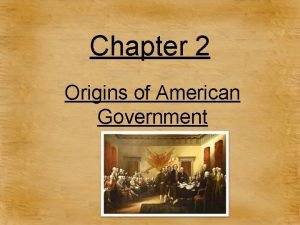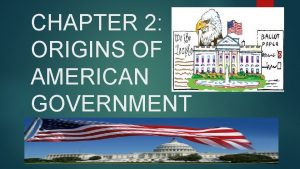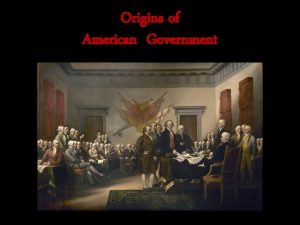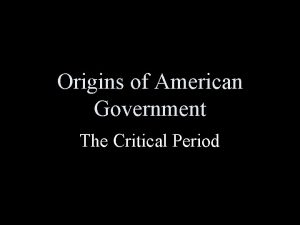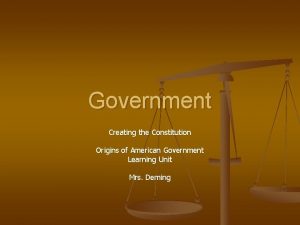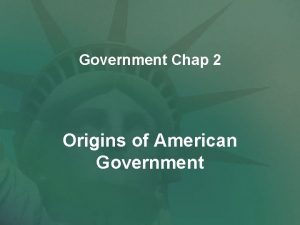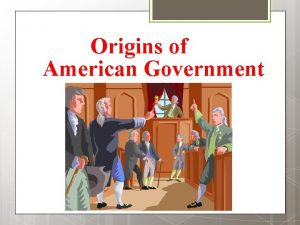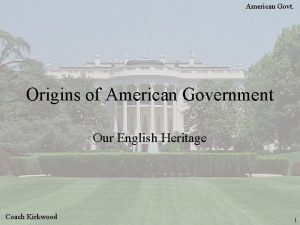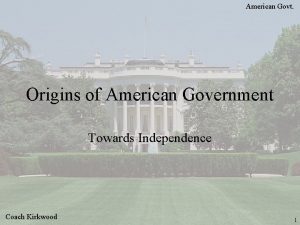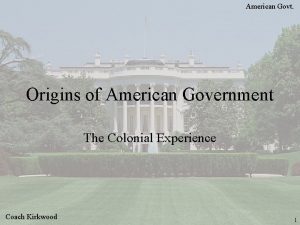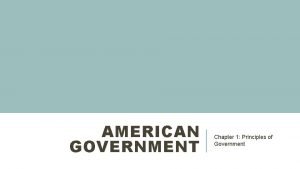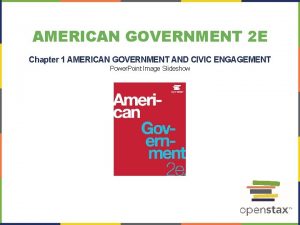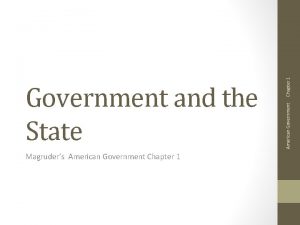Chapter 2 Origins of American Government Lesson 1















































- Slides: 47

Chapter 2 Origins of American Government

Lesson 1: Government in Colonial America • Essential Question: • What influenced the development of our government institutions?

English colonist brought three main concepts: • The need for an ordered social system, or government. • The idea of limited government, that is, that government should not be all-powerful. • The concept of representative government—a government that serves the will of the people.

Three types of colonies in North America • The royal colonies were ruled directly by the English monarchy. • The King granted land to people in North America, who then formed proprietary colonies. • The charter colonies were mostly selfgoverned, and their charters were granted to the colonists.

Limited Government • The concept that a government’s power was not absolute Magna Carta (1215) – established permanent principles of government – rights to the people

English Bill of Rights �Created in 1688 �Set clear limits on the monarch �Monarchs do NOT have the divine right to rule. They rule with consent of the people’s representatives in Parliament. �They must consult Parliament to suspend laws, levy taxes or maintain an army �Monarch can’t interfere with Parliamentary elections �People have the right to a fair and speedy trial by a jury of their peers �People should not be subject to cruel and unusual punishment or excessive fines and bail

John Locke • Wrote “Two Treatises of Government” 1690 • His ideas became the foundation for the American revolution • He believed people were born with natural rights and that government existed to protect these rights. If it can’t do this, people have the right to change their government • He believed a government was legitimate only as long as people continued to consent to it • Our Declaration of Independence and Constitution reflect these ideas

English Law • Sir William Blackstone - Commentaries on the Laws of England (1766) – Blackstone believed that the source of all human law was derived from “the law of nature and the law of revelation (the bible)” and that “no human laws should be suffered to contradict these”

Representative Government • The colonist believed in a representative government in which people elected delegates to make laws and conduct government.

The way our government works today can be traced to important documents in history:

Written Constitutions • Mayflower Compact: first colonial plan for self-government; written by the Pilgrims who landed at Plymouth • Great Fundamentals: basic system of laws that governed the people in the Plymouth and Massachusetts Bay Colony • Fundamental Orders of Connecticut: written in 1639, laid out a plan for government, gave the people the right to elect their governor, judges and representatives

Lesson 1 activity • Complete questions • Make sure you have defined the key terms

Lesson 2: Uniting for Independence • Essential Question: • Why and how did the colonists declare Independence?

French and Indian War • Struggle between England France over land in Pennsylvania and Ohio • British won the war in 1763, gained control of what would become the eastern United States • The French were driven out of North America • No need for protection, but the British needed the colonists to help pay for the war debt

Growing Colonial Unity • In 1643, several New England settlements formed the New England Confederation. • A confederation is a joining of several groups for a common purpose.

The Stamp Act Congress • In 1765, a group of colonies sent delegates to the Stamp Act Congress in New York. • These delegates prepared the Declaration of Rights and Grievances against British policies and sent it to the king. Watch video on The Boston tea party

The First Continental Congress • The colonists sent a Declaration of Rights to King George III. • The delegates urged each of the colonies to refuse all trade with England until British tax and trade regulations were repealed, or recalled. • (embargo, boycott)

The Second Continental Congress • In 1775, each of the 13 colonies sent representatives to this gathering in Philadelphia. • The Second Continental Congress served as the first government of the United States from 1776 to 1781.

American Independence • On July 4, 1776, the Second Continental Congress adopted the Declaration of Independence. • The Declaration has three main parts: 1. A statement of purpose including a description of basic human rights. 2. A list of specific complaints against King George III 3. A statement of colonists’ determination to separate from Great Britain Pg. 43 signers of the Declaration of Independence

First State Constitutions • By 1776 eight states had adopted written constitutions, which were based on the consent of the governed, limited government, and the protection of individual rights.

Lesson 2 activity • Complete Questions on handout • Make sure you define the key terms

Lesson 3: The Articles of Confederation • Essential Question: • What influenced the development of our government institutions?

Articles of Confederation • Approved November 15, 1777 • Est. “a firm league of friendship” between the states • Needed the ratification of the 13 states • March 1, 1781 Second Continental Congress declared the Articles effective Watch video America Unites - discuss

Articles of Confederation • Powers of Congress: – Make war and peace – Send and receive ambassadors – Make treaties – Borrow money – Set up a money system – Est. post offices – Build a navy – Raise an army by asking the states for troops – Fix uniform standards of weights and measures – Settle disputes amoung the states

Weaknesses of the Articles

Critical Period, the 1780’s • Revolutionary War ended on October 19, 1781 • Signed the Treaty of Paris • With Peace comes hardships – Economic problems – Political problems – Problems a result of the weaknesses of Aof. C

Critical Period, the 1780’s • Problems included – – Central government who could not act States entering into treaties States taxing on goods and banning trade Debts, public and private were unpaid • Shay’s Rebellion – – Farmers were losing their land Shut down courts Led and attack on Federal arsenal Mass. State legislature eases the burden of debtors

NEED for a Strong Central Government • Leaders who favored a stronger government failed to accomplish much at the 1786 Annapolis Convention, but persuaded the Confederation Congress to call a convention in Philadelphia to revise and update the Articles of Confederation.

Activity • Do the white board activity about the Articles of Confederation • Complete questions on handout • Make sure you define the key terms

Lesson 4: Creating the Constitution • Essential Question: • What influenced the development of our government institutions?

Framers of the Convention

Activity • Read pages 55 & 56 • Describe the following: – Virginia plan – New Jersey Plan – The Connecticut Compromise

Leaders of the Philadelphia Convention • James Madison was the co-author of the Articles of Confederation. • Gouverneur Morris was a lawyer who helped develop the U. S. system of money. • Alexander Hamilton was a lawyer who favored a strong central government. • George Washington was the successful leader of the Continental Army.

Organization and Procedures • Meet summer of 1787 in Philadelphia • Elected George Washington as president of the convention • Majority of States needed to conduct business • One vote per State on all matters • Majority of votes needed to pass proposals • Worked in Secrecy • Rhode Island did not send delegates

Father of the Constitution • James Madison: – Kept detail records of the convention – Conventions Floor leader – Contributed more to the constitution than any other • Full body settled all questions

Decisions and Compromises • Virginia Plan – proposed a strong executive, a national judiciary, and a strong two-house legislature in which the lower house would be chosen by the people and the upper house would be chosen by the lower housel. This plan favored the large, more populated states.

Decisions and Compromises • New Jersey Plan – proposed a weak executive of more than one person elected by the Congress, a national judiciary with limited powers, and a one house legislature, with one vote for each state. This plan favored the small states.

Decisions and Compromises • Connecticut Compromise – proposed a legislative branch with two parts: the House of Representatives based on population, and the Senate with two members from each state. This gave large states an advantage in the House and protected small states in the Senate.

Decisions and Compromises • Three-Fifths Compromise – Should Slaves be counted? – Split North v South – All “free person’s” will be counted; 3/5 of all other persons – Southerners could count slaves but had to pay taxes on them

Decisions and Compromises • The Commerce and Slave Trade Compromises – Congress = power to regulate foreign and interstate trade – Scared southerners – Congress: forbidden the power to tax the export of goods from any state – Could not act on the slave trade for 20 years

The Constitution is Ratified • Nine States ratified the Constitution by June 21, 1788, but the new government needed the ratification of the large States of New York and Virginia. • Great debates were held in both States, with Virginia ratifying the Constitution June 25, 1788. • New York’s ratification was hard fought. Supporters of the Constitution published a series of essays known as The Federalist.

Ratifying the Constitution • Federalists – Articles of Confederation were weak – argued for the ratification of the Constitution. – James Madison – Alexander Hamilton • Anti-Federalists – objected to the Constitution for including the strong central government – the lack of a bill of rights. – Patrick Henry, John Hancock, Samuel Adams Watch video on Ratification - discuss

Ratifying the Constitution • When the Federalists promised to add a Bill of Rights, and the small states learned about the Connecticut Compromise, the battle over ratification was finally won.

Inaugurating the Government • The new Congress met for the first time on March 4, 1789. • Congress finally attained a quorum (majority) on April 6 and counted the electoral votes. Congress found that George Washington had been unanimously elected President. He was inaugurated on April 30.

Texas v Johnson Court Case • Read page 61 • Which argument do you agree with and why? • Be prepared to discuss the outcome

Lesson 4 activity • Complete questions on handout • Make sure you define the key terms

Review Activity
 Chapter 2 lesson 1 origins of american government
Chapter 2 lesson 1 origins of american government Origins of american government vocabulary
Origins of american government vocabulary Chapter 2 origins of american government answer key
Chapter 2 origins of american government answer key Chapter 2: origins of american government worksheet answers
Chapter 2: origins of american government worksheet answers Chapter 2 origins of american government
Chapter 2 origins of american government Origins of american government section 4
Origins of american government section 4 Origins of american government section 1
Origins of american government section 1 Origins of american government section 1
Origins of american government section 1 Guided reading activity foundations of government lesson 1
Guided reading activity foundations of government lesson 1 Chapter 5 lesson 1 origins of hindu india
Chapter 5 lesson 1 origins of hindu india Chapter 2 american government
Chapter 2 american government American government chapter 4
American government chapter 4 Unit 7 lesson 4 the origins of christianity
Unit 7 lesson 4 the origins of christianity The cold war lesson 1 the cold war begins
The cold war lesson 1 the cold war begins Becoming a millionaire chapter 3 lesson 2
Becoming a millionaire chapter 3 lesson 2 Lesson 3 a new plan of government
Lesson 3 a new plan of government Chapter 15 origins of biological diversity answers
Chapter 15 origins of biological diversity answers Chapter 3 section 4 the origins of judaism answer key
Chapter 3 section 4 the origins of judaism answer key Origins of the cold war chapter 18 section 1
Origins of the cold war chapter 18 section 1 Origins of the cold war chapter 18 section 1
Origins of the cold war chapter 18 section 1 The origins of progressivism chapter 9 section 1
The origins of progressivism chapter 9 section 1 Chapter 26 section 1 origins of the cold war
Chapter 26 section 1 origins of the cold war National powers
National powers Chapter 5 lesson 2 the spanish american war
Chapter 5 lesson 2 the spanish american war Lesson 5 african american culture and politics
Lesson 5 african american culture and politics Becoming a world power lesson 3 new american diplomacy
Becoming a world power lesson 3 new american diplomacy Similarities between inca maya and aztec
Similarities between inca maya and aztec Free enterprise
Free enterprise Chapter 5 lesson 2 the spanish american war
Chapter 5 lesson 2 the spanish american war Unit 1 study guide government
Unit 1 study guide government Unit 1 foundations of american government
Unit 1 foundations of american government Foundations of american government unit 1 test review
Foundations of american government unit 1 test review What are the 6 purposes of government
What are the 6 purposes of government Chapter 1 lesson 1 your total health
Chapter 1 lesson 1 your total health Lesson 3 the role of government in economic systems
Lesson 3 the role of government in economic systems Lesson 3 big business
Lesson 3 big business Government unit 3 lesson 3
Government unit 3 lesson 3 Lesson 2 settlement culture and government of the colonies
Lesson 2 settlement culture and government of the colonies Lesson 2 the three branches of government
Lesson 2 the three branches of government Sociolgist
Sociolgist History of curriculum
History of curriculum Magic of kefir
Magic of kefir Hunger games chapter 21 questions and answers
Hunger games chapter 21 questions and answers Historical origins of the health belief model
Historical origins of the health belief model Rastafari origins
Rastafari origins Origins cwv 101
Origins cwv 101 Origins of the cold war
Origins of the cold war Origins of the cold war
Origins of the cold war
